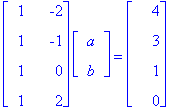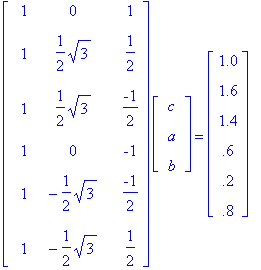Find the Least Squares Solution to 3 Lines
Problem Set 4: Some Least Squares Solutions
These closely follow the procedures and examples on pages 8--13 of the class Lecture Notes: Vectors and Least Squares10. Use the Method of Least Squares to find the straight line that best fits the following data given by the points (x,y):
| x | -2 | -1 | 0 | 2 |
| y | 4 | 3 | 1 | 0 |
Solution: Step 1.
If the first data point lies on this straight line y=a + bx, then

Step 2. Since there are more equations than unknowns, it is highly unlikely that this equation AX=Y has an exact solution. Instead, using the Method of Least Squares we seek a solution X that minimizes the error ||AX-Y||. As we saw, this leads us to solve the normal equations A*AX=A*Y. We already proved in class that the adjoint of A is the transpose of A (that is, A* = AT). Therefore the normal equations are: ATAX = ATY. In detail:

After doing the computation this is just

Step 3. We have 4a - b = 8 and -a + 9b = -11. This is a simple linear equation whose solution is

11. The water level in the North Sea is mainly determined by the so-called M2 tide, whose period is about 12 hours. The height H(t) thus roughly has the form

where time t is measured in hours. Say one has the following measurements:
| t (hours) | 0 | 2 | 4 | 6 | 8 | 10 |
| H(t) (meters) | 1.0 | 1.6 | 1.4 | 0.6 | 0.2 | 0.8 |
Use the method of least squares with these measurements to find the constants a, b, and c in H(t) for this data.
Solution: The same method applies as in the previous problem. Ideally we would like the six data points to satisfy the equation
Rewrite these six equations in the three unknowns (c, a, b) as a matrix equation: AX = Y.

To solve for the X giving the smallest error ||AX-Y||, we solve the normal equations: A*AX = A*Y. This is best done using a computer. Proceeding by hand we get

that is,

Solving these we find that 3a = sqrt(3), 3b = 0.8, and 6c = 5.6. Therefore
The resulting formula for y=H(t) is:

12. Find a plane of the form
that best fits the following five points: (0, 0, 1.1), (1, 1, 2), (0, 1, -0.1), (1,0,3), (0, -1, 2.1).
Solution: This is very similar to #10, except now there are five equations for the three unknowns (a, b, c). A computer package such as Maple makes this simple.
13 a). Some experimental data (x_i, y_i) is believed to fit a curve of the form
The method of least squares does not apply directly to this since the parameters a and b do not appear linearly. Show how to find an equivalent equation to which the method of least squares does apply.
Solution: Multiply the equation by a + bx2 to get the equivalent equation
Find the Least Squares Solution to 3 Lines
Source: https://www2.math.upenn.edu/~kazdan/210/210F06/hw/solns/hw4solns.html